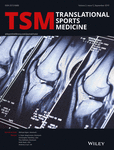Using ultrasonography to detect loss of muscle mass in the hospitalized geriatric population
Abstract
Background and purpose
Hospital admission for older patients has been linked to loss of muscle mass and function, and the former can be measured with ultrasonography during hospitalization.
Methods
Two studies were carried out. In Study 1, 69 patients' (85 ± 8 years) activity level was measured with ActivPal and quadriceps thickness measured twice with ultrasonography during hospitalization. In Study 2, 10 older patients (85 ± 8 years) and 10 healthy young subjects (23 ± 2 years) had their quadriceps thickness measured on two consecutive days with ultrasonography that included a pressure calibrator.
Results
In Study 1, the results revealed that the older patients had a reduction in thigh muscle thickness together with very low levels of activity level during hospitalization. Patients with a <95% inactivity level show a 1.8% reduction in muscle thickness, and those with a >95% inactivity level had a 7.0% reduction. In Study 2, ultrasonographic measurements were performed using a pressure calibrator, and these results yielded very good reproducibility. Typical error was 1.7% for the young and 7.2% for the old persons. This high reproducibility and low error improve the ability to detect significant changes over time.
Conclusion
Improving the ultrasonography method including use of a pressure calibrator can result in greater reproducibility.
CONFLICT OF INTEREST
None of the authors declare any conflict of interest, financial, or otherwise.




